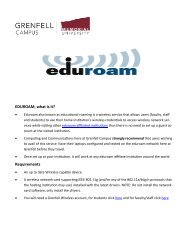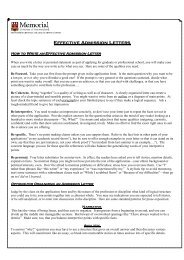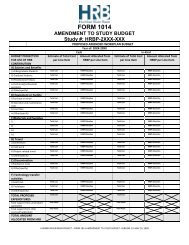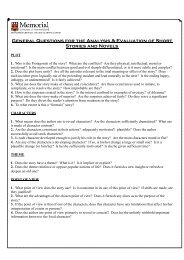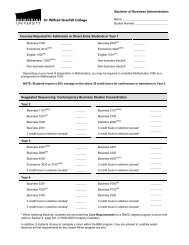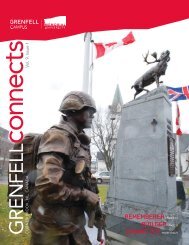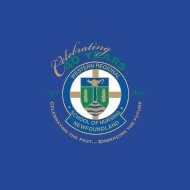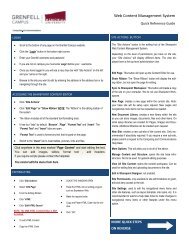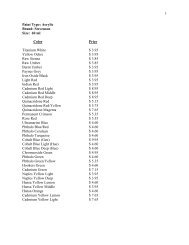How to Write a Summary - Sir Wilfred Grenfell College
How to Write a Summary - Sir Wilfred Grenfell College
How to Write a Summary - Sir Wilfred Grenfell College
You also want an ePaper? Increase the reach of your titles
YUMPU automatically turns print PDFs into web optimized ePapers that Google loves.
SIR WILFRED GRENFELL COLLEGE LEARNING CENTRE<br />
<strong>How</strong> <strong>to</strong> <strong>Write</strong> a <strong>Summary</strong><br />
In a summary (also referred <strong>to</strong> as a précis or abstract), you reduce material in an original work <strong>to</strong> its<br />
main points and key supporting details. The length of your summary will depend on your instruc<strong>to</strong>r’s expectations and<br />
the length of the article. Most often you will be asked <strong>to</strong> write a summary of one or more paragraphs. Writing a summary<br />
brings <strong>to</strong>gether a number of important reading, writing, and study skills. To condense the original matter, you must<br />
preview, read, evaluate, organize, and perhaps outline the assigned material. Summarizing, then, can be a real aid <strong>to</strong><br />
understanding; you must “get inside” the material and fully realize what is being said before you can reduce is meaning <strong>to</strong><br />
a few words.<br />
1. Take a few minutes <strong>to</strong> preview the book.<br />
<strong>How</strong> <strong>to</strong> Preview a Book<br />
You can preview or survey a book by taking a quick look at the following:<br />
a) TITLE: the title is often the shortest summary of the content of a book. Think about the title for a minute and<br />
how it may summarize the whole meaning of the work.<br />
b) TABLE OF CONTENTS: the contents will tell you the number of chapters in the book and the subject of<br />
each chapter. Use the contents <strong>to</strong> get a general sense of how the book is organized.<br />
c) PREFACE: may give reason for why the author wrote the book, or may summarize the main ideas developed<br />
in the book.<br />
d) FIRST & LAST CHAPTERS: in these chapters, the author may preview or review important ideas or<br />
themes developed in the book.<br />
e) OTHER ITEMS: note the way the author has used headings and subheadings <strong>to</strong> organize information in the<br />
book. Check the opening and closing paragraphs of each chapter <strong>to</strong> see if they contain introduction or summaries. Look<br />
quickly at charts, diagrams, and pictures in the book since they are probably there <strong>to</strong> illustrate key points. Note any<br />
special features (index, glossary, appendixes) that may appear at the end of the book.<br />
<strong>How</strong> <strong>to</strong> Preview an Article<br />
You can preview an article in a magazine by taking a quick look at the following:<br />
a) TITLE: even more than with a book, the title often summarizes the article’s content. Think about the title for<br />
a minute and how it may condense the meaning of the article.<br />
b) SUBTITLE: a subtitle, if given, is a short summary appearing under or next <strong>to</strong> the title. For example, in a<br />
PSYCHOLOGY TODAY article entitled “superkids”, the following caption appeared: “No one knows why some children<br />
who grow up under horrendous conditions – in homes with abusive, psychotic, or desperately poor parents – seem <strong>to</strong><br />
develop in<strong>to</strong> extraordinary competent human beings.” In short, the subtitle, caption, or any other words in large print or<br />
next <strong>to</strong> the title often provide a quick insight in<strong>to</strong> the meaning.<br />
c) FIRST & LAST SEVERAL PARAGRAPHS: in the first several paragraphs, the author may introduce you<br />
<strong>to</strong> the subject and state the purpose of the article. In the last several paragraphs, the writer may present conclusions or a<br />
summary. These previews or summaries can give you a quick overview of what the entire article is about.<br />
d) OTHER ITEMS: note any headings or subheadings that appear in the article. They often provide clues <strong>to</strong><br />
the article’s main points and give an immediate sense of what each section is about. Look carefully at any pictures,<br />
charts, or diagrams accompanying the article. Page space in a magazine or journal is limited, and such visual aids are<br />
generally used when they help illustrate important points in the article. Note any words or phrases set off in italic or<br />
boldface type; such words have probably been emphasized because they deal with important points in the article.
<strong>How</strong> <strong>to</strong> <strong>Write</strong> a <strong>Summary</strong> (cont.)<br />
2. Read the book or article for all you can understand the first time through. Do not slow down or turn back. Check or<br />
otherwise mark main points and key supporting details. Pay special attention <strong>to</strong> all the items noted in the preview. Also,<br />
look for definitions, examples, and enumerations. You can also identify important points by turning headings in<strong>to</strong><br />
questions and reading <strong>to</strong> find the answers <strong>to</strong> questions.<br />
3. Go back and re-read more carefully the areas you have identified as most important. Also, focus on other key points<br />
you may have missed in your first reading.<br />
4. Take notes on material. Concentrate on getting down the main ideas and key supporting points.<br />
5. Prepare the first draft of your summary, keeping these points in mind:<br />
a) At the start of the summary identify the title and author of the work. Include in parentheses the place of<br />
publication, publisher, and publication date.<br />
b) Do not write an overly detailed summary. Remember, the purpose of a summary is <strong>to</strong> reduce the original work<br />
<strong>to</strong> its main points and essential supporting details.<br />
c) Express the main points and supporting details in your own words! Do not imitate or stay <strong>to</strong>o close <strong>to</strong> the<br />
style of the original work.<br />
d) Quote from the material only <strong>to</strong> illustrate key points.<br />
e) Preserve the balance and proportion of the original work. If the original concentrated 40 pages on one area and<br />
only 3 pages on another, your summary should reflect that emphasis.<br />
f) Revise the first draft, paying attention <strong>to</strong> the principles of effective writing (unity, support, organization, and<br />
clear, error-free sentences)<br />
g) <strong>Write</strong> a final draft of the paper.<br />
A model summary of a magazine article follows:<br />
MODEL SUMMARY<br />
In an article titled “On Magic in Medicine” (Human Nature, January 1979), Lewis Thomas describes the widespread<br />
tendency <strong>to</strong> create easy and simplistic explanations for our most serious diseases. In the past, for example, many people<br />
believed tuberculosis was caused by night air and insufficient sunlight. This untested theory remained widely accepted<br />
until science identified the single proven cause of the disease: the tubercle bacillus. Today there is a popular theory <strong>to</strong><br />
explain cancer, heart disease, stroke, and other diseases about which science is still largely ignorant. The theory is that<br />
people become ill because they do not live right. They do not practice such basic health habits as eating breakfast,<br />
exercising regularly, not smoking, and not drinking <strong>to</strong> excess. In fact, however, there is no conclusive scientific evidence<br />
that keeping fit will ward off deadly diseases or add years <strong>to</strong> one’s life. Yet, people will continue <strong>to</strong> believe in “magic”<br />
explanations and solutions until science comes in with cold, hard facts.<br />
This information has been compiled and/or adapted by the Learning Centre. Please Drop by AS 234 and meet the assistants.<br />
Revised 2004




